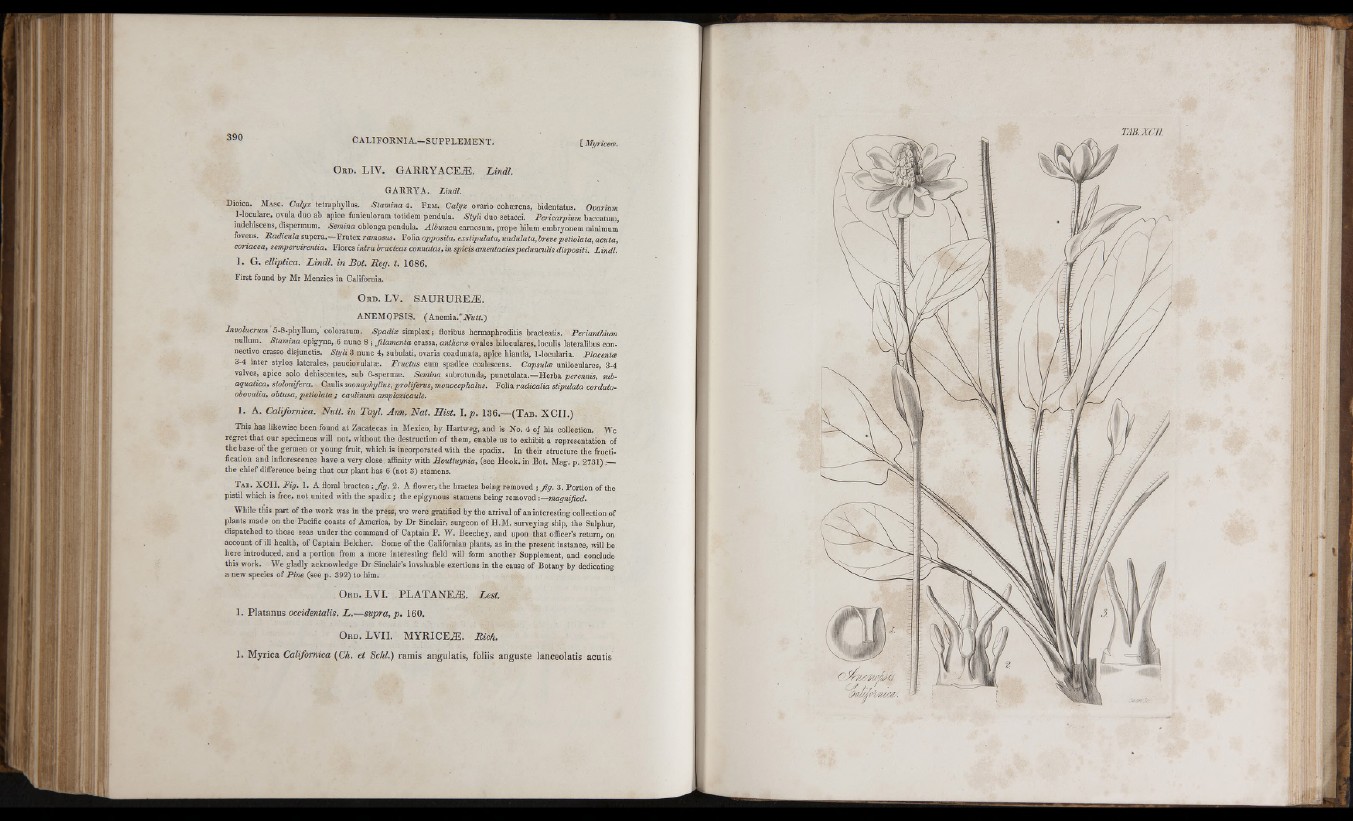
E
O r d . L IV . G A E R Y A C EÆ . L indl.
GARRYA. Lindl.
Dioica. M asc. Calyx tetraphyllus. Stamina 4 . F em . Calyx ovario cohærens, bidentatus. Ovarium
1-locuIare, ovula duo ab apice funiculorum totidem pendula. Sty li duo setacei. Pericarpium baccaium,
indehiscens. dispermum. Semina oblonga pendula. Albumen carnosum, prope hilum embryonem minimum
fovens. Farficuto supera.—Frutex ramosws. Folia oyj^osiVa, exstipuiatuyundulata,brevepetiolata,acuta,
cortacea, sempervirentia. Flores intra bracteas connatas, in spicis amentacies pedunculis dispositi. Lindl.
1. G . elliptica. L in d l. in Bot. Reg. t. 1686.
First found by Mr Menzies in California.
O r d . LV . S A U R U R E Æ .
ÂNEMOPSIS. (Anemia.‘'iVa«.)
Involucrum 5-8-phyllum, coloratum. simplex ; floribus hermaphroditis bracteatis. Perianthium
nullum. Stamina epigyna, 6 nunc 8 ; filamenta crassa, antheræ ovales biloculares, loculis lateralibus con-
nectivo crasso disjunctis. Styli 3 nunc 4, subulati, ovaria coadúnala, apice hiantia, 1-locularia. Placentce
3-4 inter stylos laterales, pauciovulatæ. Fructus cum spadice coalescens. Capsulæ uniloculares, 3-4
valves, apice solo dehiscentes, sub 6-spermæ. Semina subrotunda, punctulata.—Herba perennis, sub-
aquatica, siolonifera. Caulis rnonophyllus, proliféras, monocephalus. Folia radicalia stipulata cordato-
obovalia, obtusa, petiolata ; caulinum amplexicaule.
1. A. Californica. N u tt, in Ta yl. Ann. N a t. H is t. \ . p . 136.— (T a b . X C I Ï .)
This has likewise been found at Zacatecas in Mexico, by Hartweg, and is No. 4 of bis collection. We
regret that our specimens will not, without the destruction of them, enable us to exhibit a representation of
thebase of tbe germen or young fruit, which is incorporated with the spadix. In their structure the fructification
and inflorescence have a very close affinity with Hmtluynia, (see Hook, in Bot. Mag. p. 2731) :__
the chief difference being that our plant has 6 (not 3) stamens.
Tab. X C II. Fig. 1. A floral bractea ; fig . 2. A flower, the bractea being removed ; fig . 3. Portion of the
pistil which is free, not united with the spadix j the epigynous stamens being removed -.—magnified.
While this part of the work was in the press, we were gratified by the arrival of an interesting collection of
plants made on the Pacific coasts of America, by Dr Sinclair, surgeon of H.M. surveying ship, the Sulphur,
dispatched to those seas under the command of Captain F. W. Beechey, and upon that officer’s return, on
account of ill health, of Captain Belcher. Some of the Californian plants, as in the present instance, will be
here introduced, and a portion from a more interesting field will form another Supplement, and conclude
this work. We gladly acknowledge Dr Sinclair’s invaluable exertions in the cause of Botany by dedicating
a new species of Pine (see p. 392) to him.
O r d . L V I. P L A T A N E Æ . Lest.
1. P la tan u s occidentalis. L .—supra, p . 160.
O r d . L V I I . M Y R IC EÆ . Rich.
1. Myric a Californica {Ch. et Schl.) ramis angulatis, foliis anguste lanceolatis acutis
TAB. x c n .
-
. if
lllip llj’
1' “i1*
l â h
í í i " ' 1